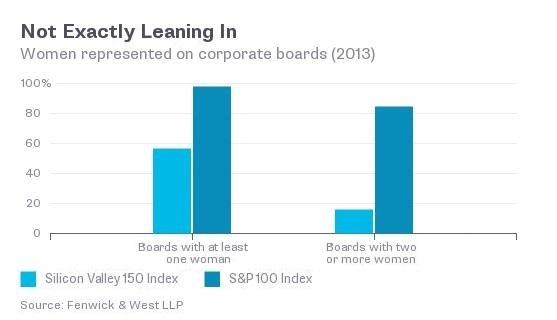Over the last 50 years, women have made great strides in the classroom, the labor force and the income tables. There is one place progress has been slow, however: in corporate boardrooms. This is not only unfair but also uneconomical — and it’s all visible in a single chart:

Companies with at least one female director had better returns for six straight years. Which raises the question: If the financial argument for gender diversity is so compelling, then why aren’t companies recruiting more women to their boards? Or, to put it more broadly, why do public companies need an incentive to do something that is clearly in their own interest?
One answer is that they don’t, necessarily. Nevertheless, they aren’t moving fast enough. Among the Standard & Poor’s 500 companies, women make up only 18 percent of directors; in Europe, the comparable figure is 14 percent. In Silicon Valley — home to some of the fastest-growing companies in the world and with a disproportionate effect on the U.S.’s economic future — it’s even worse:

In other words, almost all members of the elite S&P 100 have at least one female director. In Silicon Valley, 43 percent of the top 150 companies (by revenue) have not a single female director.
One solution to this dearth of women may be demographic. As more women graduate from college — in most advanced economies, their graduation rate is now higher then men’s — eventually more women will find their way to boardrooms and corner offices. Except that this isn’t necessarily true. By 2035, studies show, women will still be underrepresented:

In Silicon Valley, again, the shortage is even more acute. Only 20 percent of computer-science grads are women, down from 37 percent in 1985. The proportion of women in computer jobs declined to 27 percent in 2011 from 37 percent in 1990. Overall, women make upalmost half the workforce. Yet they aren’t choosing careers in science, technology, engineering and math:

So demographics won’t solve this problem. What about regulation? Should countries adopt quotas forcing companies to add more women to their boards?
If Norway’s experience is any guide, that’s not necessarily a good idea, either. (And Italy, France and Belgium, which have adopted similar quotas that go into effect in coming years, may want to take note.) In 2008, Norway imposed a quota for public companies: 40 percent of their board members needed to be women. The results were dramatic.
First, half of the companies on the Oslo Stock Exchange delisted to avoid the mandate. Those that remained met the quota but had to scramble to find qualified candidates. Many companies (begrudgingly) ousted more senior male directors to bring on younger, less experienced women. Many of these companies borrowed more, made questionable acquisitions and reported lower results:

What explains the difference between the first chart and this last one? The same thing that explains the difference between a company that casts a wide net to voluntarily recruit (and nurture) qualified women, and one that adds women to its board simply to comply with a quota. The solution, unsatisfying as it sounds, is that companies have to realize for themselves what’s in their own best interest.
None of this proves cause and effect; gender-diverse companies may just happen to be better run. Yet there’s a pile of research showing that boards and other leadership panels with 50 percent women think more critically, which may explain the better results. Group dynamics change for the better when both sexes are present. Diverse groups solve problems better than homogeneous ones do, possibly because the men and women monitor each other’s performance more closely. Companies might also find it helps to expand their talent search. Tech companies, for example, don’t necessarily need STEM graduates as directors, or even women with previous board experience.
Outside pressure, sensibly applied, can help force change. Canada, for example, is asking companies to commit to a goal of 30 percent women on boards by 2020. In the U.K., the 30 Percent Club, which favors gender diversity without resorting to quotas, is pushing for 30 percent by the end of 2015.
Equality is a worthy goal on its own terms, of course. But for the corporate world, the better rationale for gender diversity is financial.
To contact the senior editor responsible for Bloomberg View’s editorials: David Shipley at davidshipley@bloomberg.net.


